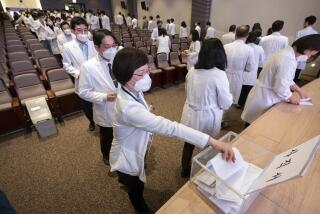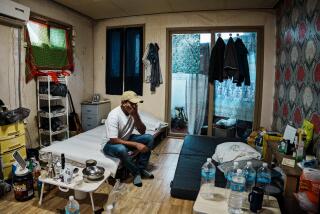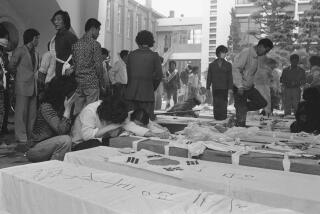- Share via
SEOUL — Oh Young-jun traces the outlines of superheroes.
The stoop of a nurse’s shoulders as she carries buckets brimming with biohazard waste. The tangle of a towel holding up hair dripping wet from a shower after hours in a hazmat suit. The momentary reprieve of a nurse sitting upright and nodding off in a desk chair, her hand propping up a face bandaged in spots where protective equipment has chafed her skin.
Oh knows these details well. They are images that take shape during the days and nights of his shifts as an ICU nurse at a hospital in Incheon, a South Korean port city about an hour west of Seoul.
Those hours have become more harrowing with the arrival of the novel coronavirus that’s plaguing hospitals around the world. Earlier this year, Oh volunteered to be one of the nurses staffing an isolation ward for those stricken with COVID-19. He has since been caring for critically ill patients in cumbersome protective gear that has made unwieldy many of the tasks he once did with ease in his eight years as a nurse.
And on his days off, the 34-year-old art school dropout-turned-nurse picks up his stylus and sketches intimate scenes of life and death as seen through his goggled eyes and felt through his gloved hands.
His trench in this fight is removed from the front lines of the battle — the hardest hit in South Korea was the city of Daegu and surrounding areas in the southeast of the country, where hospitals were overwhelmed by a surge of several thousands at the height of the country’s outbreak in late February.
Some of those patients were transferred to Oh’s hospital to relieve hospitals at the epicenter. Among Oh’s charges were a 93-year-old woman with dementia who was one of the country’s oldest infected with the coronavirus, and a 57-year-old man with chronic renal failure who’d been receiving dialysis for 25 years before the virus ravaged his lungs.
Caring for those patients has meant spending his days off away from friends and family, mostly cooped up in his apartment, for fear of spreading the virus.
Hence, more time to draw.
It was around the time of South Korea’s last major epidemic that Oh began drawing scenes from his work as a nurse and posting them on social media.
In early 2015, Oh was a couple years out of nursing school and feeling settled in the rhythm of his work at Gachon University Gil Hospital. He decided to capture the day-to-day lives of nurses. In Korean television dramas and other media, nurses were often shown as overly feminine, subordinate, sexualized characters; menial assistants helping doctors rather than professionals in their own right.
That was reflected in the way many patients and family members spoke to and treated nurses — addressing them as “miss” or “you there,” raining them with demands and abuse without the deference shown to physicians.
He wanted people to see what he saw, the grueling hours, the humanity, the sacrifice, the hushed toll at shift’s end.
Oh had loved to draw since he was young but realized a couple years into art school how few make it as successful full-time artists. He decided to follow in the footsteps of his childhood hero Florence Nightingale and enrolled in nursing school.
Because he majored in Korean paintings and primarily focused on landscapes, drawing people and the intricate medical equipment populating the ICU took time to master.
In sparse drawings, as if whispers on a page, he used rough strokes and few colors. He began chronicling a sporadic series titled “Nursing Story” on Facebook — part work diary, part medical notes and part personal journal exploring the woes, joys and everything in between of life as a nurse.
He portrayed uncontrollable patients with alcohol withdrawal delirium who wreak havoc at the hospital and need to be restrained. Young children peering through the doors of the ICU for a glimpse of their mother because kids under 13 aren’t allowed to visit. Abuse from patients, working through nights, holidays and illnesses, and quiet cries in the laundry room where the whirring of machines mask the sobs.
He quickly gained a following, comments flooding in from fellow nurses who saw their lives reflected in his drawings. They chimed in with their own stories.
In May, 2015, the Middle East respiratory syndrome, a deadly illness caused by another coronavirus, began spreading in South Korea.
Many hospitals, including Oh’s, weren’t prepared to handle the outbreak, lacking isolation beds and protective equipment. A doctor was infected in Seoul, putting medical workers on edge. Oh’s hospital asked for volunteers to staff a ward for patients showing symptoms of the virus.
Oh was as scared as anyone. But as a young, single person living alone, he thought better him than other colleagues with families. He was the first to volunteer. Two others, a shift chief and a section head, said through tears they would step up too.
“Wearing protective suits, N95 masks and goggles, enduring CO2 retention, moisture, sweat and dehydration — MERS or not.... we nurses are always by the patient’s side,” he wrote in a post accompanying a drawing of a nurse walking down a darkened hallway in head-to-toe protective gear.
When cases of the novel coronavirus began cropping up outside China earlier this year, he didn’t hesitate to volunteer to work in the isolation ward, emboldened by that experience. If anything, it felt like a welcome departure from his normal ICU routine.
South Korea, too, was ready. Many hospitals had set up negative pressure isolation wards and separate departments to handle infectious disease outbreaks. Protective equipment, of which there had been a shortage in 2015, was in ready supply for medical professionals. Despite an early surge that made South Korea the largest cluster outside of China, the country appeared to get a handle on local transmissions that brought societies elsewhere to a halt and caused staggering numbers of deaths.
In mid-March, Oh, who has a wry humor, warned his followers, whose numbers have swelled to some 85,000 between Facebook and Instagram, that he’d be posting more from his days off in isolation.
“Apologies, you may get corona fatigue from frequent updates,” he wrote.
In his dispatches, he portrayed himself and others trying to insert an IV line with layers of gloves, nervously monitoring X-rays of a gravely ill patient’s fogged-up lungs, rushing to intubate a patient from whom phlegm spewed “like rust-laden water from a water spout.”
To minimize the number of people going in and out of the isolation ward, nurses were having to take on many more tasks, including sterilizing surfaces and equipment, disposing of biohazard waste and catering to patients’ every need, he wrote.
“Nurses do all of it. They’re remarkable beings,” he wrote. “I’m not grumbling about this situation. It’s all corona’s fault.”
He knows nurses and other medical professionals elsewhere are fighting tougher battles, overwhelmed by large numbers of critically ill patients with limited ventilators and scant protective equipment, many of them becoming infected and, increasingly, dying. In South Korea, at least 241 medical workers had been infected with the coronavirus.
A former colleague of Oh’s who moved to the U.S. to work as a nurse there — something many South Korean nurses aspire to because of better pay and working conditions — told him of dire shortages of protective equipment at her hospital in Chicago.
“It sounded like us during MERS — pandemonium,” he said in an interview.
In South Korea’s coronavirus fight, Oh’s patients have brought a degree of hope. The 93-year-old patient with dementia and the 57-year-old long-term dialysis patient have, after much sweat and tears from Oh and his colleagues, recovered from COVID-19 and been discharged. South Korea’s daily coronavirus infections this week dipped below 50 for the first time since late February, after surging by more than 900 a day at its peak.
Oh knows from experience, there is always the next patient, the next crisis, the next epidemic. He goes on doing his part in his corner of the medical profession — lately, long night shifts during which he refrains from water or caffeine because of the time it takes to shed his protective equipment to use the bathroom.
When his shift is over, as the city whirs to life, he shuts his eyes and does his best to invite the sleep that never comes easily after years of switching from days to nights and back again.
And on his days off, he sketches.
More to Read
Sign up for Essential California
The most important California stories and recommendations in your inbox every morning.
You may occasionally receive promotional content from the Los Angeles Times.











